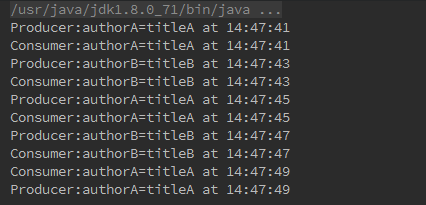通过前面的文章,我们知道任何一个Java对象,都拥有一组监视器方法,主要包括wait()、notify()、notifyAll()方法,这些方法与synchronized关键字配合使用可以实现等待/通知机制。而且前面我们已经使用这种方式实现了生产者-消费者模式。类似地,Condition接口也提供类似的Object的监视器的方法,主要包括await()、signal()、signalAll()方法,这些方法与Lock锁配合使用也可以实现等待/通知机制。
相比Object实现的监视器方法,Condition接口的监视器方法具有一些Object所没有的特性:
- Condition接口可以支持多个等待队列,在前面已经提到一个Lock实例可以绑定多个Condition,所以自然可以支持多个等待队列了
- Condition接口支持响应中断,前面已经提到过
- Condition接口支持当前线程释放锁并进入等待状态到将来的某个时间,也就是支持定时功能
使用Condition接口配合Lock锁的使用实例如下:
Lock lock = new ReentrantLock(); Condition condition = lock.newCondition(); public void conditionWait() throws InterruptedException { lock.lock(); try { //.... condition.await(); }finally { lock.unlock(); } } public void conditionSignal(){ lock.lock(); try { //... condition.signal(); }finally { lock.unlock(); } }
- 1
- 2
- 3
- 4
- 5
- 6
- 7
- 8
- 9
- 10
- 11
- 12
- 13
- 14
- 15
- 16
- 17
- 18
- 19
- 20
- 21
- 22
一般而言,都会将Condition变量作为成员变量。当调用await方法后,当前线程会释放锁并进入Condition变量的等待队列,而其他线程调用signal方法后,通知正在Condition变量等待队列的线程从await方法返回,并且在返回前已经获得了锁。
现在我们已经知道了如何配合Condition和Lock锁实现等待/通知机制,那么我们使用这种方式实现生产者-消费者模式:
package com.rhwayfun.concurrency.r0405;import java.text.DateFormat;import java.text.SimpleDateFormat;import java.util.Date;import java.util.concurrent.TimeUnit;import java.util.concurrent.locks.Condition;import java.util.concurrent.locks.Lock;import java.util.concurrent.locks.ReentrantLock;/** * Created by rhwayfun on 16-4-5. */public class ConditionProducerConsumerDemo { //日期格式器 private static DateFormat format = new SimpleDateFormat("HH:mm:ss"); static class Info{ //作者 private String author; //标题 private String title; //是否开始生产的标志 private boolean produce = true; //Lock锁 private Lock lock = new ReentrantLock(); //Condition变量 private Condition condition = lock.newCondition(); public Info(){} public Info(String author, String title) { this.author = author; this.title = title; } public String getAuthor() { return author; } public void setAuthor(String author) { this.author = author; } public String getTitle() { return title; } public void setTitle(String title) { this.title = title; } /** * 生产者执行的生产方法 * @param author * @param title * @throws InterruptedException */ public void set(String author,String title) throws InterruptedException { lock.lock(); try { //没有开始生产就等待 while (!produce){ condition.await(); } //如果已经开始生产 this.setAuthor(author); TimeUnit.SECONDS.sleep(1); this.setTitle(title); //表示已经停止了生产可以取数据了 produce = false; //通知消费者 condition.signal(); }finally { lock.unlock(); } } /** * 消费者执行的消费方法 * @throws InterruptedException */ public void get() throws InterruptedException { lock.lockInterruptibly(); try { //如果已经开始生产就等待 while (produce){ condition.await(); } //如果没有在生产就就可以取数据 System.out.println(Thread.currentThread().getName() + ":" + this.getAuthor() + "=" + this.getTitle() + " at " + format.format(new Date())); //表示我已经取了数据,生产者可以继续生产 produce = true; //通知生产者 condition.signal(); }finally { lock.unlock(); } } } static class Producer implements Runnable{ private Info info; public Producer(Info info) { this.info = info; } public void run() { boolean flag = true; for (int i = 0; i < 5; i++){ if (flag){ try { info.set("authorA","titleA"); System.out.println(Thread.currentThread().getName() + ":" + info.getAuthor() + "=" + info.getTitle() + " at " + format.format(new Date())); TimeUnit.SECONDS.sleep(1); } catch (InterruptedException e) { e.printStackTrace(); } flag = false; }else { try { info.set("authorB","titleB"); System.out.println(Thread.currentThread().getName() + ":" + info.getAuthor() + "=" + info.getTitle() + " at " + format.format(new Date())); TimeUnit.SECONDS.sleep(1); } catch (InterruptedException e) { e.printStackTrace(); } flag = true; } } } } static class Consumer implements Runnable{ private Info info; public Consumer(Info info) { this.info = info; } public void run() { for (int i = 0; i < 5; i++){ try { info.get(); TimeUnit.SECONDS.sleep(1); } catch (InterruptedException e) { e.printStackTrace(); } } } } public static void main(String[] args) throws InterruptedException { Info info = new Info(); Thread producer = new Thread(new Producer(info),"Producer"); Thread consumer = new Thread(new Consumer(info),"Consumer"); producer.start(); TimeUnit.SECONDS.sleep(1); consumer.start(); }}
- 1
- 2
- 3
- 4
- 5
- 6
- 7
- 8
- 9
- 10
- 11
- 12
- 13
- 14
- 15
- 16
- 17
- 18
- 19
- 20
- 21
- 22
- 23
- 24
- 25
- 26
- 27
- 28
- 29
- 30
- 31
- 32
- 33
- 34
- 35
- 36
- 37
- 38
- 39
- 40
- 41
- 42
- 43
- 44
- 45
- 46
- 47
- 48
- 49
- 50
- 51
- 52
- 53
- 54
- 55
- 56
- 57
- 58
- 59
- 60
- 61
- 62
- 63
- 64
- 65
- 66
- 67
- 68
- 69
- 70
- 71
- 72
- 73
- 74
- 75
- 76
- 77
- 78
- 79
- 80
- 81
- 82
- 83
- 84
- 85
- 86
- 87
- 88
- 89
- 90
- 91
- 92
- 93
- 94
- 95
- 96
- 97
- 98
- 99
- 100
- 101
- 102
- 103
- 104
- 105
- 106
- 107
- 108
- 109
- 110
- 111
- 112
- 113
- 114
- 115
- 116
- 117
- 118
- 119
- 120
- 121
- 122
- 123
- 124
- 125
- 126
- 127
- 128
- 129
- 130
- 131
- 132
- 133
- 134
- 135
- 136
- 137
- 138
- 139
- 140
- 141
- 142
- 143
- 144
- 145
- 146
- 147
- 148
- 149
- 150
- 151
- 152
- 153
- 154
- 155
- 156
- 157
- 158
- 159
- 160
- 161
- 162
- 163
- 164
- 165
- 166
- 167
- 168
- 169
- 170
- 171
- 172
- 173
运行结果如下:
与使用Object的监视器方法达到了同样的效果,也许看不出Condition配合Lock锁的优势何在。但是在复杂多线程的编程中,这种方式可以体现出其优势。所以一般使用的时候仍然是Object的监视器方法居多。
再分享一下我老师大神的人工智能教程吧。零基础!通俗易懂!风趣幽默!还带黄段子!希望你也加入到我们人工智能的队伍中来!https://blog.csdn.net/jiangjunshow
